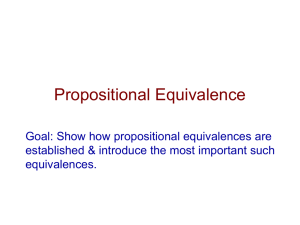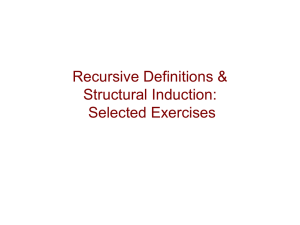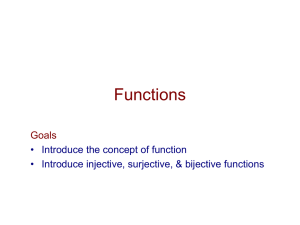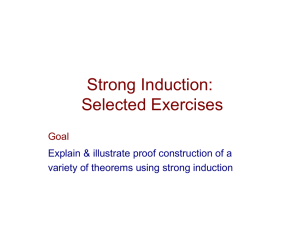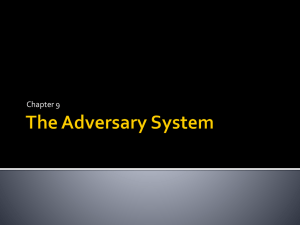1.6 - UCSB Computer Science
advertisement
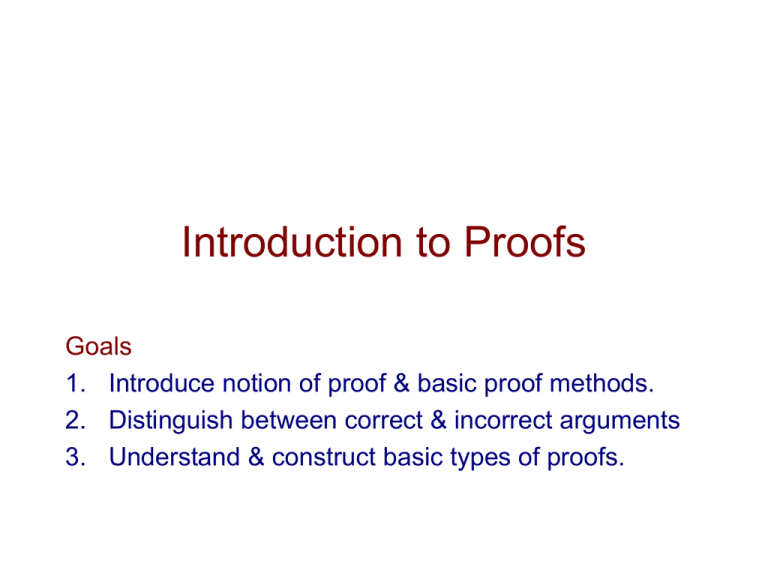
Introduction to Proofs Goals 1. Introduce notion of proof & basic proof methods. 2. Distinguish between correct & incorrect arguments 3. Understand & construct basic types of proofs. Introduction • Proof: A valid argument establishing the truth of a mathematical statement. • In CS, we want to prove – the correctness of an algorithm or program – more generally, a property of an algorithm/data structure, program, or system (e.g., Java can be parsed efficiently?) – – – – AI strategies, automated theorem proving the consistency/feasibility of a specification consequences of a mathematical model of computing ... Copyright © Peter Cappello 2 Methods for Proving Theorems • A theorem typically is of the form x ( P( x ) Q( x ) ). • The proof method typically is of the form 1. Let c be an arbitrary element in the domain. 2. Show that P( c ) Q( c ) is true. (The essence.) 3. Therefore, x ( P( x ) Q( x ) ). Copyright © Peter Cappello 3 Direct Proof of p q 1. Assume that p is true. 2. Show that q is true. Example – Let the domain be the integers. – Prove: x ( ( 3 | x – 2 ) ( 3 | x2 – 1 ) ) Proof: WHAT WHY 1. Let x be an arbitrary integer such that 3 | x – 2. 2. Let integer q = ( x – 2 ) / 3. (from step 1 & definition of “|”) 3. x = 3q + 2. (algebraic manipulation of step 2) (premise) 4. x2 = ( 3q + 2 )2 = 9q2 + 12q + 4 = 3( 3q2 + 4q + 1 ) + 1. 5. x2 – 1 = 3( 3q2 + 4q + 1 ). 6. 3 | x2 – 1. (subtract 1 from both sides of step 4) (from step 5 & definition of the meaning of “|”) 7. Therefore, x ( ( 3 | x – 2 ) ( 3 | x2 – 1 ) ) Copyright © Peter Cappello (Universal Generalization) 4 Proof by Contraposition of p q Direct proof of the contrapositive: ~q ~p 1. Assume q is false. 2. Show that p is false. Copyright © Peter Cappello 5 Proof by Contraposition of p q Example The domain is the set of integers. Prove: a b ( (ab is even) (a is even b is even) ) Proof WHAT WHY 1. Let a, b be arbitrary integers. 2. Assume (a is even b is even). 3. a is odd b is odd. (De Morgan’s law) 4. m ( a = 2m + 1 ) n ( b = 2n + 1 ). (Defn. of odd.) 5. ab = (2m + 1)(2n + 1) = 4mn + 2m + 2n + 1 = 2(2mn + m + n) + 1 which is odd. 6. a b ( (ab is even) (a is even b is even) ) (U.G.) Copyright © Peter Cappello 6 Proof by Contradiction of p q Show p q is true by showing that (p q) ≡ ( p q) ≡ (p q) is false: 1. Assume p q. 2. Show that this leads to a contradiction. If you need to show x P( x ) You may assume x P( x ), then show that this leads to a contradiction. Copyright © Peter Cappello 7 Example If 1, 2, …, 10 are placed randomly in a circle then the sum of some 3 adjacent numbers 17. Proof: 1. Place 1, 2, …, 10 randomly in a circle. (Premise) 2. Assume that the sum of no 3 adjacent numbers 17. 3. Then, x1 + x2 + x3 16 (explain with diagram) x2 + x3 + x4 16 x3 + x4 + x5 16 … x10 + x1 + x2 16. 4. Sum the 10 inequalities: 3( x1 + x2 + . . .+ x10 ) 16 10 = 160 3(1 + 2 + … + 10) 160 3*55 = 165 160, a contradiction. 5. Our assumption is false: If 1, 2, …, 10 are placed randomly in a circle then the sum of some 3 adjacent numbers 17. Copyright © Peter Cappello 8 Proving p q p q ≡ (p q) (q p) ≡ (p q) (p q) To prove p q it is necessary & sufficient to show either: (p q) (q p), or equivalently (p q) (p q) Copyright © Peter Cappello 9 Presentation Perhaps the clearest proof presentation: – Give a numbered list of statements, where the last statement is the statement to be proved – For each statement, explain why its truth follows from: • previous statements • premises • previously established mathematical facts or definitions. Copyright © Peter Cappello 10



